Karesansui: Japan's Zen Gardens and 5 Famous Places to Visit

The karesansui style of Japanese gardening is founded on Zen ideology and uses rocks and sand to express nature and the universe. Read on to learn the features of Zen gardens, a brief history of the concept, and five famous Zen gardens you can visit in Japan.
Japan's Zen Gardens
What Are Zen Gardens (Karesansui)?
Brief History of Zen Gardens
Types of Karesansui Zen Gardens
5 Famous Zen Gardens in Japan
1. Ryoanji Temple (Kyoto)
2. Shodenji Temple (Kyoto)
3. Daitokuji Zuihoin Temple (Kyoto)
4. Tenryuji Temple (Kyoto)
5. Soryoukan (Kaga)
Karesansui: Recreating a Natural Landscape Using Rocks and Sand

Photo by Pixta
If you’ve ever been to Kyoto’s Ryoanji Temple, perhaps you remember being transfixed by the sight of its beautiful garden. There are fifteen rocks of varying sizes placed in Ryoanji’s white sand garden, and it is said that no matter where you sit, you will always be unable to see one of the rocks.
When you go around and visit Japanese Zen temples, gardens of laid-out stones are a common sight; these sand and rock gardens, which express images of mountains and rivers without using water, are called karesansui.
Karesansui can also be called by other names like kasansui, furusansui, and arasensui, but the contents and images expressed by the garden do not change. They are often referred to as Zen gardens in English because they emphasize contemplation, or "dry gardens" because they use sand and rocks.
There are several types karesansui, such as gardens of only rocks, or gardens which create a beautiful contrast between greenery and white rocks and sand. Going to several different temples and comparing their gardens can be an enjoyable experience.
Karesansui gardens express water surfaces and wave motions through sand patterns called samon. Some gardens also put bridges above the sand to simulate the flow of rivers.
A garden’s expression of nature also changes according to the sizes of the stones and grains of sand. Since the sand patterns are disrupted by rain or the landing of birds, they must be redrawn at regular intervals. Karesansui gardens require exceptionally delicate care.
Brief History of Zen Gardens
The history of creating waterless gardens in confined spaces dates back to the 11th century. Zen ideology was popular in the 14th century, when the samurai became powerful. As the white sand scattered in gardens symbolized purity, they became sites for rituals and ceremonies.
Before long, ceremonial venues moved indoors, and karesansui gardens were created to serve as spaces for contemplation and Zen meditation.
How to Spend Time in a Zen Garden
Zen gardens are not meant for strolling, but for contemplation; they are made for visitors to focus their gaze on as they consider the meaning of space. The garden that occupies the area is not just a representation of mountains, rivers and nature; it expresses a Buddhist worldview about absolute minimalism.
Situate yourself in the garden and you will arrive at the Zen spiritual concept of nothingness. While Japan is overflowing with noise, the appeal of the karesansui garden lies in its place as a sanctuary to separate yourself from the chatter and quietly engage in self-reflection.
Types of Karesansui Zen Gardens

Photo by Pixta
Altogether, there are six types of karesansui Zen gardens. We’ll take a look at these six types and examine some notable temple gardens in each style.
1. Hiraniwa (Flat Garden)
The garden at Ryoanji in Kyoto is an example of this style, which is constructed on flat land.
2.Jun-Hiraniwa (Semi-Flat Garden)
The gardens at Daitokuji Honbo Jotei in Kyoto and Fugenji Teien in Yamaguchi are examples of this style, which adds short mountains to the hiraniwa style.
3. Kareike (Dry Pond)
The garden at Nishi-Honganji Taimenjo in Kyoto is an example of this style, which uses arrangements of stones to create the appearance of a pond.
The garden at Seiganji in Kyoto uses moss to represent the pond; when it rains, the water collects in the moss and it becomes an actual pond.
4. Karenagare (Dry Stream)
The gardens at Daisenin Hojo Totei in Kyoto and Nansoji in Osaka are examples of this style, which express the movement of flowing water through sand patterns and small stones.
5. Tsukiyama (Artificial Hills)
This karesansui style makes use of inclines to express waterfalls and flowing water. You can see examples of this style at Tenryuji and Saihoji in Kyoto.
6. Unique Gardens
These gardens are either only made with white sand, or do not fall into any of the above categories. Some representative gardens are Kogetsudai, Ginshadan, and Tokai-an Hojo Nantei in Kyoto.
Naturally, Kyoto has plenty of these karesansui gardens. Use this article as a hint guide and compare them for yourself!
5 Famous Zen Gardens in Japan
Many Zen temples in Japan have karesansui gardens. We introduce some of the most representative ones below.
1. Ryoanji Temple

Photo by Pixta
Ryoanji Temple's karesansui is a particularly famous Zen garden. The arrangement of stones and the expression of flowing water created with the white sand is just beautiful. There are 15 stones carefully placed in the garden, designed so that you can enjoy a different view from each angle.
Ryoanji was built in 1450 during the Muromachi Period and is a Rinzai sect temple. The garden was created as spiritual training grounds for the monks, and expresses nature through the combination of stones and sand.
This garden reflects the principles of Zen Buddhism, and is a place where you can particularly feel the concepts of both "nothingness" and "existence."
Ryoanji
Address: Kyoto, Ukyo, Ryoanji Goryoshitacho 13
Access: 10 minute walk from Ryoanji-mae Kyoto City Bus stop or a 15 minute walk from Ryoanji Station on JR Sagano Line.
Website: http://www.ryoanji.jp/smph/ (Japanese)
2. Shodenji Temple
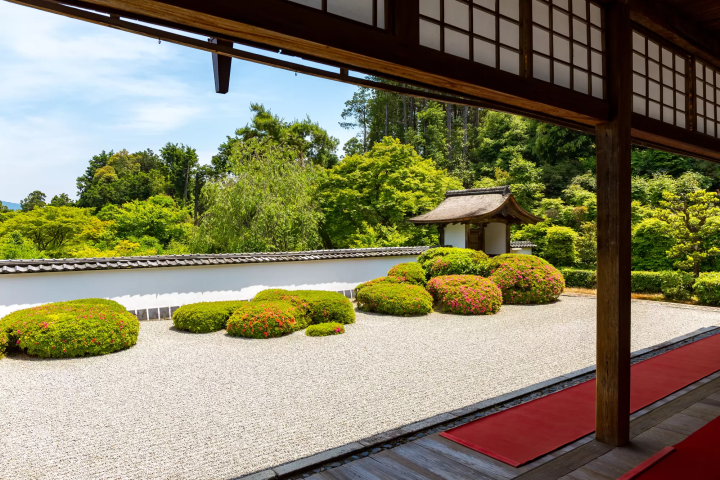
Photo by Pixta
This Zen garden beautifully combines an arrangement of moss and stone. The entire garden is composed like one giant painting, and the beauty of the moss particularly stands out. Moss is an essential element of Japanese gardens and provides visitors with a sense of peace.
Shodenji was founded in the Muromachi period and is a Zen Buddhist temple. This garden in particular inherited the traditions found in Japanese gardens passed down from the Heian period. Shodenji has been properly maintained in recent years, ensuring that visitors can find peace of mind when stepping into this environment.
Shodenji
Address: Kyoto, Ukyo, Keihoku Shitamachi Terada 18
Access: From Kameoka Station on JR Sanin Main Line, take a bus to Keihokucho Yakuba-mae stop, and then walk for about 10 minutes.
Website: https://shodenji-kyoto.jp/ (Japanese)
3. Daitokuji Zuihoin Temple
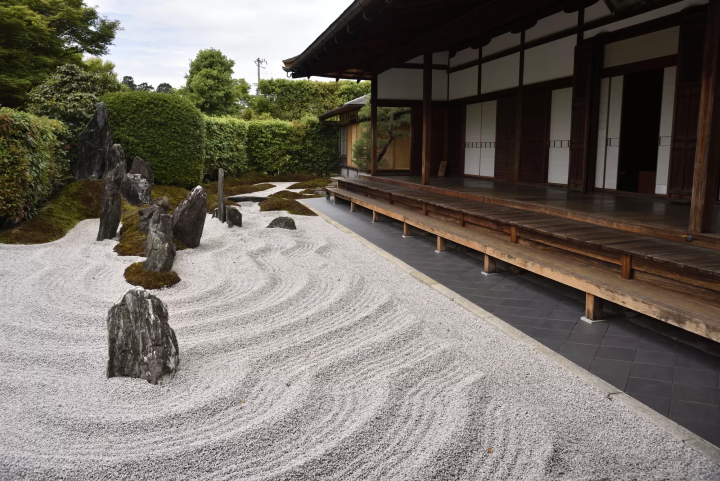
Photo by Pixta
At Daitokuji Zuihoin's garden, a large stone is placed in the center, and the surrounding sand represents the flow of water around it. Here, you can find peace of mind in silence while experiencing the principles of Zen.
If you stroll through the garden at dusk, you'll be in awe at how much more beautiful the stones and sand becomes, pulling you into its fantastical atmosphere.
In the distance you'll see beautiful mountains surrounding the garden, allowing you to become one with nature. Zuihoin's garden was laid out during the Edo period, and has since been loved by many people seeking peace of mind.
Daitokuji Zuihoin
Address: Kyoto, Kita, Daitokuji-cho 26
Access: 5-minute walk from Daitokuji-mae Kyoto City Bus stop
Website: https://www.kyoto-ga.jp/greenery/kyononiwa/2016/05/post_22.html
4. Tenryuji Temple
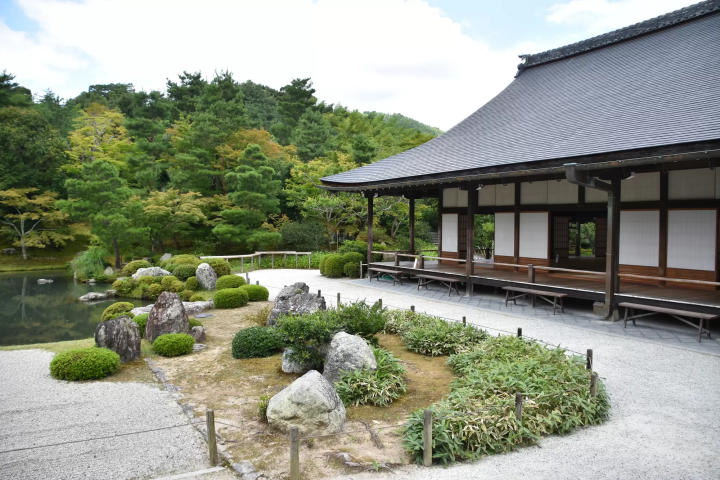
Photo by Pixta
Registered as a World Heritage Site, Tenryuji's Zen garden is a representative example of karesansui. This garden is centered around a pond, and its attractiveness comes from it harmonizing with the mountains towering behind it.
The stoneworks and plants in the garden imitate scenes of nature, providing a sense of healing to its visitors.
Tenryuji was founded in 1339, and it is known as the head temple of the Rinzai sect of Buddhism. The garden has been there since its founding, and the garden's design was influenced by Chinese landscape paintings in particular.
After experiencing turmoil during the Warring States period, the garden underwent extensive renovations in the Edo period, and now stands with its current appearance.
Tenryuji
Address: Kyoto, Kameoka, Kita, Nishiindayamacho 4
Access: About a 10-minute walk from Saga-Arashiyama Station on the JR Sanin Main Line.
Website: https://www.tenryuji.com/en/
5. Soryoukan
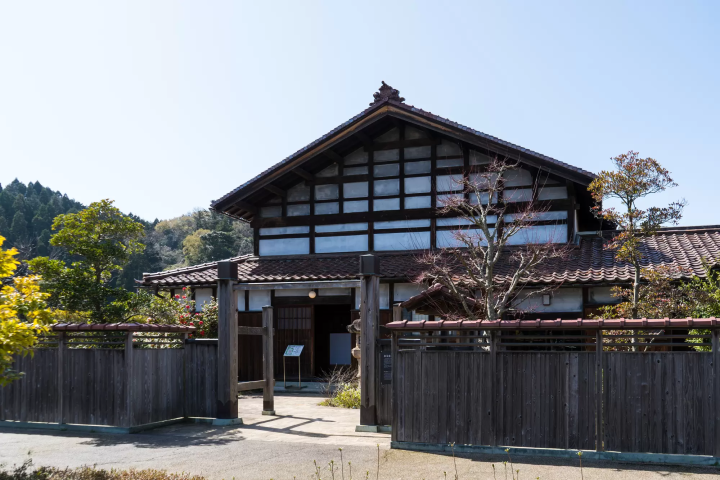
Photo by Pixta
Soryoukan was the residence of Kubo Hikobei, a Kitamaebune shipowner from Kaga, active during the end of the Edo period until the Meiji era. Originally, it was located by the sea in Hashidate, Kaga City, which has since been designated as an Important Preservation District for Groups of Traditional Buildings by the national government.
Since then, it was relocated and restored to its current location near Daishoji Station over a period of three years from 2000.
The Soryoukan has karesansui gardens on three sides of the residence. The gardens were created in the 2000s when the residence was relocated, and they were designed by Ishimura Landscape Gardening, a local company in Daishoji.
Soryoukan's "inner garden" can be seen from the tatami room at the back of the building. Its main garden is made up of two rock gardens, the "Ship Stone Garden" and the "Waves Garden."
The Ship Stone Garden uses stones to represent five Kitamaebune ships sailing out into the Sea of Japan. The Waves Garden represents Hashidate's Kasano Cape and the rough waves crashing on the shore.
Soryoukan
Address: Ishikawa, Kaga, Kumasakacho 28-3
Access: From Kaga Onsen Station take the Kaga Tour Bus to "32 Yamanoshita Temples/Ishikawa Prefecture Kutani Pottery Museum" bus stop, and walk for 5 minutes.
Website: https://www.tabunkanet.com/ (Japanese)
日本への訪日外国人の方が、もっと増えますように!

























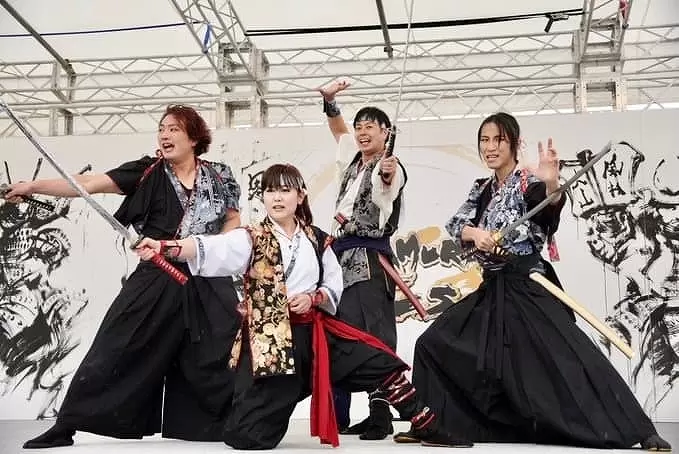









![[30 minutes by train from Nagoya] Feature Articles cherry blossom viewing spots in the tourist destination of Tokoname](https://resources.matcha-jp.com/resize/720x2000/2026/01/08-255150.webp)
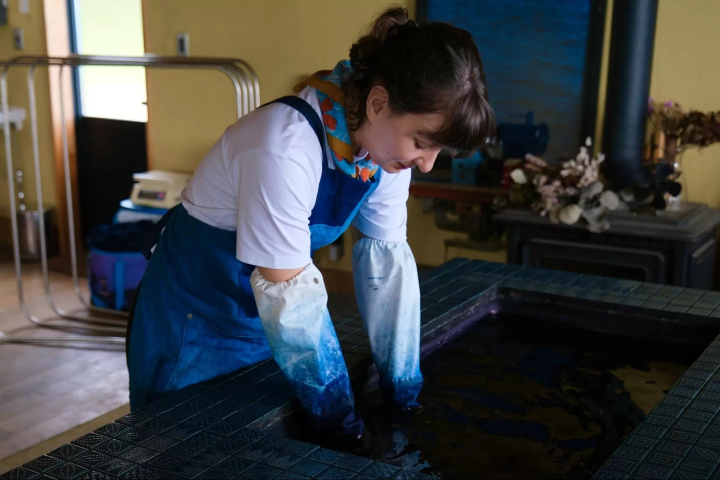


![[2026] Top 5 Strawberry Picking Spots in Tokushima, Naruto| Farms and Access Guide for January to May](https://resources.matcha-jp.com/resize/720x2000/2025/03/06-227165.webp)